Bombs on Sweden

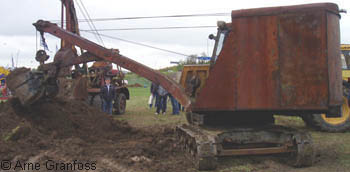 UNDER CONSTRUCTION Version 0.41
UNDER CONSTRUCTION Version 0.41
|
Sweden in World War II - across borders
|
 |
![]()
Even though Sweden was neutral during World War II, it was not free from military activities that killed or wounded Swedes. On this page I have collected fragments foremost about events in Sweden, but also some that took place in other sites.
![]()
A German fighter plane fired by mistake at the commercial airplane between Malmö and Amsterdam on 26 September 1939. One man was killed. [s04]
![]()
On 5 December 1939 the Swedish navy had laid 90 mines near Åland, most in Swedish waters but some in international waters. Finland laid 190 submarine mines nearby on 9-14 December, some of them in Swedish waters. [s59]
![]()
On 13 December 6 men were killed on the larger armoured ship "Manligheten", near Gothenburg, when a wire from a German mine sweep was hauled in and a grenade on it exploded. [s71]
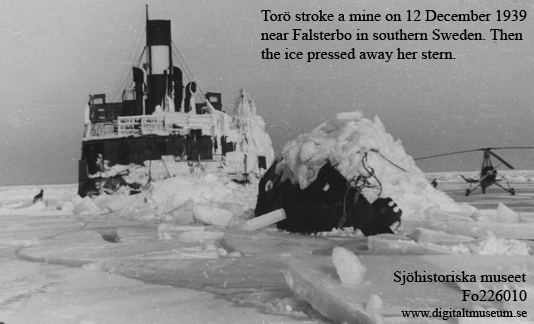
![]()
The Allies dropped mines in the southern Baltic Sea, south of Sweden. [s52]
![]()
During the Winter War between the Soviet Union and Finland (30 November 1939 - 12 March 1940), around ten Soviet Union submarines were active in the Baltic Sea. Not many merchant ships were sunk, and foremost smaller ships. (More German than Finnish ships were sunk). [s59]
On 5 January 1940 the Soviet Union submarine SC311, in Swedish waters, attacked the Swedish steamer Fenris with its gun. The steamer stopped and signalled, but the shelling continued. It is said that the submarine continued the shelling from 300 metres distance for half an hour before a grenade hit the boiler room. Meanwhile the crew of 14 persons had rowed to a nearby Swedish lighthouse ship (which also got minor damage by a grenade that exploded close to that ship). [s59]
On 31 January 1940 two Swedish and one Finnish merchant ship left Åbo in Finland to sail to Sweden. The fairway was swept for mines, and a Finnish ice breaker with an anti-aircraft gun acted as convoy leader. The ships made a pause in Åboland archipelago on the 3rd, waiting in the ice with some 700 meters between them. The crews were ordered to wait on one of the islands. In the early afternoon of the 5th two Soviet Union bombers attacked. The Swedish ship s/s Wirgo was not hit by any bombs, but bomb splinters had made holes on her starboard side. A new escort ice breaker lead the ships on towards Sweden, Wirgo sailing with a list towards her portside to keep the holes on her starboard above the water line. They started during the night to the 6th and reached Ålands archipelago in the morning, where they left the ships in the ice and the crew walked to an island. Later she leaned over to the other side, and crewmembers ran out to the ship and started the pumps. Too late. Wirgo sank. [s59]
Fenris and Wirgo were the two Swedish ships who were sunk in the Baltic Sea during the Winter War, incidentally both with the same commander. [s59]
![]()
In early January 1940 the Swedish ship Svartön lost contact in the fog with a convoy between Norway and Britain, escorted by British naval ships. She was sunk by a German submarine, and 20 men were killed. [s59]
![]()
Soviet bombs fell on the Swedish town Pajala Kyrkby in early 1940, apparently by mistake. [s05]
![]()
Some Swedish ships were in Norway when Germany attacked on 9 April 1940. S/s C.F. Liljevalch lay close to a steep mountain side in northern Norway, when planes attacked. No bombs hit. Most of the crew walked to Sweden, while some worked at a local farm. Later they sailed the ship towards Sweden, but it was captured by Germans and sailed to Kiel. A week later it again had the Swedish flag. M/s Balboa arrived in Norway on 9 April, and anchored in the long Sognefjorden. She was attacked by German planes, but not hit. As the Germans advanced, those who wanted were escorted to the Swedish border by Germans. Two months later she got German naval escort to Sweden. [s65]
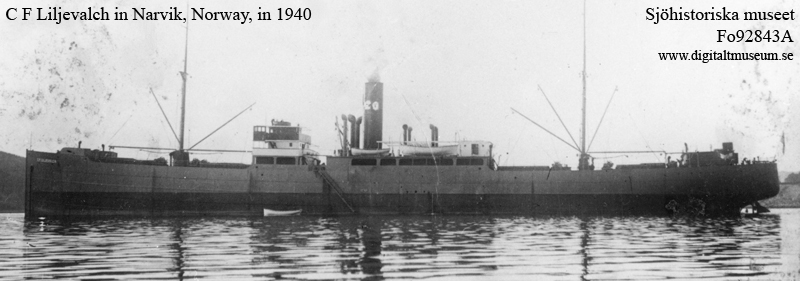
C.F. Liljevalch was torpedoed on 18 August 1942. [s73]
On 13 August 1940 the Swedish s/s Mongolia arrived in the Kiel Bay with iron ore, where a German pilot got onboard. At 18.40 she was destroyed by a mine, but noone was killed. Probably it was a British magnetic mine, one of many that were dropped in the area, and which were dangerous for ships filled with magnetic iron ore. [s59]
Another Swedish ship with iron ore to Germany sunk by a mine was s/s Sigrid, close to the Kiel channel. She broke in two and sank within 30 seconds, and 11 men were killed. [s59]
Gondul hit a mine on the Swedish west coast on 2 October 1940. On 29 May 1943 she hit another mine, in the southern Baltic Sea. [s73]

![]()
Some foreign defence equipment against attacking planes also caused problems for Sweden. The first, and largest, 'attack' took place on the west coast of Sweden around 17 September 1940. During those days 120 loose anti-aircraft balloons drifted in over Sweden, and their long ropes that dragged on the ground caused shortcuts when they passed electric, telegraph and telephone lines. Anti-aircraft balloons mostly flew to Sweden when the weather was stormy. [s49]
Offensive balloon weapons also landed in Sweden, the maybe lesser known 'fire balloons'. They had a device that began to burn when the balloons landed. The first of these landed on the west coast on 7 June 1943, but luckily caused no serious damage. [s49]
![]()
![]()
![]()
The small Swedish tanker m/t Uno was chartered by Germany, and sailed from Gotenhafen (former Polish Gdynia) towards Memel with distilled water for batteries in German submarines when she hit a mine on 22 November 1941. One man was killed. [s59]
![]()
The Finnish cargo ship s/s Argo was sunk with one torpedo from the Soviet Union submarine SC 317 on 16 June 1942. 9 men were killed, and 14 rescued by the Swedish s/s Ulla. Later the same day the same submarine sent two torpedoes towards s/s Ulla, but both missed. [s59]
(The same day, the commander of the Swedish navy had told his subordinates that there might be Soviet Union submarines operating in the Baltic Sea. Also on that day, the Swedish supreme commander gave the order for a minefield at Märket-Understen to prevent unwanted submarines to sail into the northern Baltic Sea (Bottenhavet). The mines were in place on the 19th. However the Finnish mines that should block the Finnish waters were not laid until in September.) [s59]
The submarine continued southwards along the Swedish coast, and damaged the Danish s/s Orion on the 19th west of Gotska Sandön. On the 22nd the ship was towed to Visby by a Swedish navy ship. [s59]
That torpedo attack led to the start of Swedish navy escort for traffic between the Swedish mainland and the island Gotland from 21 June. From the 22nd escort and patrol ships were in duty in the Landsort-Kalmarsund area too. [s59]
At mid day 22 June 1942 the same submarine sunk the Swedish s/s Ada Gorthon east of the island Öland. She had large letters on her sides with her name and the word Sweden (but for the Soviet Union iron ore could be seen as material for the German war industry). 22 men were killed. The lookout man saw the periscope 400 metres away and then the track of a torpedo. After 25 seconds the torpedo hit midships, and the heavy cargo fore and aft broke the ship in two parts that sank in 30 seconds. [s59]
On the 25 June the Swedish minister in Moscow gave the Soviet Union an demarché with a demand to stop the submarine incidents, a protest the Soviet Union initially refused to receive. [s59]
The Swedish 'ketch' Fortuna fortunately was missed by the same submarine's 8th torpedo (of 10). [s59]
![]()
Another Soviet Union submarine, SC 406, missed the target s/s Galeon on 1 July 1942. A Swedish destroyer started a hunt for the submarine, but it had escaped. For the second time remains of Soviet Union torpedoes were found, and the Soviet Union minister in Stockholm was requested to meet the Swedish prime minister. And even though the Soviet Union was innocent, they should again instruct their navy to respect the Swedish territory. [s59]
On 6 July the same submarine attacked a southbound convoy, and again missed the target but hit a skerrie. In the submarines diary it was noted: 14.28, double torpedo shot, ship sank. Again Swedish depth charges were used, but the submarine got away. [s59]
A Swedish plane discovered the submarine on 21 July, and released depth charges. The submarine got away, and attacked another convoy on the 22nd. This time more than 50 depth charges were sent towards the submarine, but she got away and back to the Soviet Union. [s59]
![]()
The Soviet Union submarine S 7 was made ready for an expedition on the night to 2 July 1942, with the instruction to sail along the Swedish coast towards Kalmarsund and to foremost sink ships with iron ore to Germany. [s59]
On 7 July the crew on s/s Margareta saw a submarine without nationality signs near Arkösund. Swedish submarines had exercises in these waters, and further south German submarines had an exercise area. After several minutes the torpedo was fired, and s/s Margareta was sunk. 14 men were killed, while 4 survived. [s59]
Two torpedoes missed s/s Noreg on 9 July, and a Swedish S 5 Hansa plane missed the submarine. [s59]
On 11 July S 7 spotted a convoy of 29 merchant ships near Västervik, with two smaller naval ships as escort. The captain of S 7 chose to send two torpedoes towards one of the largest ships. The second torpedo hit, and m/s Luleå sank within 90 seconds with 8 men and 9,000 metric tonnes of iron ore. Depth charges were launched, but ... [s59]
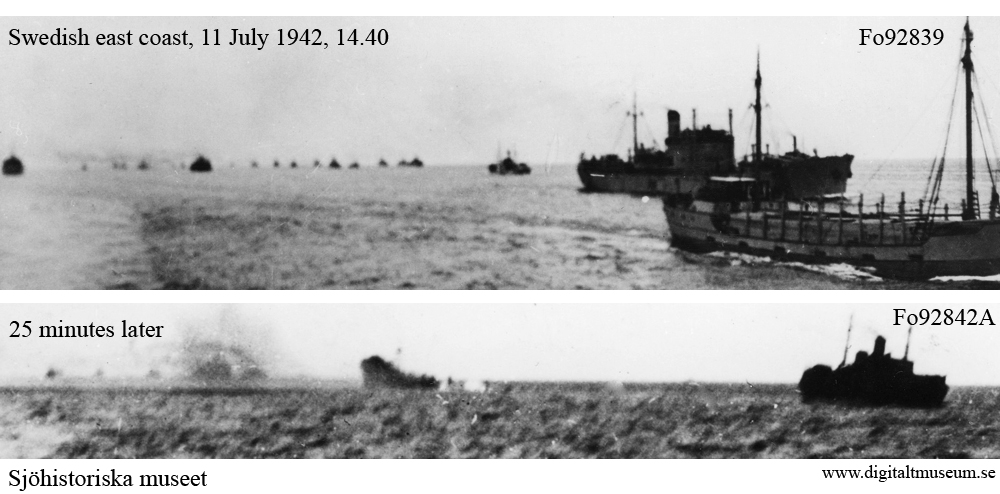
The Swedish navy's description of the hunt for the submarine that sank m/s Luleå, with 26 depth charges, was not confirmed by the commander of the Soviet Union submarine. He had later been caught by the Finns, and the Germans had questioned him. He had confessed to the sinking of m/s Luleå, but said that he had not noticed any depth charges. [s63]
S 7 failed to hit ships in two other convoys on 13th and 14th. Both times it was hunted by Swedish naval ships. Then the captain asked to get another operation area, and was on 18 July moved to the coast along Kurland - on the eastern side of the Baltic Sea. [s59]
![]()
Soviet Union submarine L 3 left Kronstadt 9 August 1942 with 18 torpedoes and 20 mines. Captain Gristjenko discovered a convoy on 17 August, and managed to catch up with it the following day near Västervik. The Swedish s/s C.F. Liljevalch was hit by two torpedoes, and sank within 35 seconds with 32 crew members and a pilot. 7 men survived. Depth charges were used this time too. [s59]
The night to 22 August the Swedish navy laid 4 minefields with 200 mines attached for submarines on periscope depth. Also torpedo boats began to patrol the area at night. No more submarines were seen in the area for the rest of WWII. [s59]
L 3 continued southwards to the German coast. [s59]
On 19 September a torpedo from D 2 was close to hit the Swedish train ferry Konung Gustaf V south of Sweden. [s59]
Wrecks of submarines found in the 1990s indicates that other Soviet Union submarines also operated in Swedish waters. [s59]
There are some indications that a Soviet Union submarine (SC 406) sank s/s Bengt Sture on her usual trade with iron ore to Germany and coal to Sweden, south of Sweden around 29 October 1942 - and that about half a dozen Swedes were rescued, captured and brought to Leningrad. [s59]
![]()
On 6 November 1942 s/s Lidingö was sunk by a magnetic mine near the Kiel channel. The crew rowed the lifeboats to another Swedish ship a couple of hundred metres away, s/s Belos. On board it was discovered that one man was missing, and a motorboat was sent to Lidingö where the man stood on deck. He had fallen some 11 metres into the steamers half full coal box, broke an arm and fainted for a short time. As the ship sank more and more water ran into the coal box, and the water lifted him up to the top of the coal box so that he could crawl out of it. [s59]
The tanker Castor was sunk in the North Atlantic by a German submarine. s/s Aspen was bombed and sank on the way to Rotterdam with iron ore. To mention a few of them. [s59]
The Swedish government said no to the idea of anti-aircraft guns on Swedish merchant ships. [s63]
![]()
On 7 January 1943 three ships left Göteborg, for Buenos Aires. From the German control station in Kristiansand m/t Svea Jarl, m/s Brasil and m/s Ecuador sailed in a row. In the morning of 9 January they sailed through a German minefield near Stavanger. The passage had been used several times during two years by Swedish "lejdtrafiken" ships, and was also used by German ships. Maybe the first ship, that lacked echo-sounder that could aid to find the correct position, sailed a little too far to the west? [s64]
Sveajarl (with 40 men) hit a mine, and then another mine, and began to list too much for the portside lifeboats to be used. Some crew left the ship, while others tried to save her. They managed to restart a support engine, and the lights went on. This made half of the men in lifeboats turn back towards Sveajarl. [s64]
When the crew on the second ship, Brasil, saw Sveajarl hit the first mines they reversed the engine. They had begun to launch a lifeboat, when the ship hit a mine. The explosion was so powerful that some of the cargo was threwn out from cargo bays. The four lifeboats with all the crew left Brasil within three minutes, and two minutes later Brasil hit another mine. The men rowed to m/s Ecuador. [s64]
Meanwhile a third mine exploded under Sveajarl. After hard struggle, one lifeboat with 25 survivors was rowed towards the undamaged Ecuador. After one hour of rowing they met two lifeboats from Ecuador, launched to aid the survivors. The three men with the worst burn injuries were taken onboard one of Ecuadors lifeboats. Then all three lifeboats were rowed towards Ecuador. [s64]
9 January is in the middle of the cold winter in this area, and they had to row directly against the wind. The waves were high, and increasing snow sleet decreased the visibility. None of the lifeboats had an engine. [s64]
The weather got worse. Another lifeboat was launched from Ecuador and set drifting in the wind towards the three lifeboats, attached to Ecuador with a 1,000 metres long line to shorten the distance the crews had to row. On Sveajarls lifeboat they failed to set the sail, and the lifeboat was blown away and disappeared. The sails were set on the lifeboats from Ecuador, but were not so useful in the strong headwind. Only one lifeboat reached Ecuador, around 16 o'clock, and Ecuador backed out of the area. [s64]
Ecuador had a motorized lifeboat, but concern about its function in the cold weather (at freezing temperature) and the (at the time) good weather condition made them use the lighter rowing boats instead. The engine on the motorized lifeboat from Brasil was said to have had a couple of stops on the way to Ecuador, and also this lifeboat was considered unsuitable to aid survivors from Sveajarl. [s64]
![]()
At the end of March 1943 the Finnish and German navies blocked the Gulf of Finland, to prevent Soviet Union submarines to sail into the Baltic Sea. This also became a protection for ships in the iron ore and coal/coke traffic. [s63]
![]()
The Swedish s/s Narvik could carry 7,500 metric tonnes. Until May 1943 she managed to transport some 300,000 tonnes of iron ore to Germany, and also coal and coke from Germany to Sweden. She made at least 40 trips back and forth, probably most of them to and from Rotterdam in the Netherlands. [s63]
On 12 September 1941 she left Rotterdam in a convoy, and British bombers attacked. A 250 kilogram bomb hit Narvik, but didn't explode. Another bomb hit the aft of the ship and bounced away before it exploded. However bombs exploded around her, and she began to leak. The plane's machine guns also caused damage. The sinking ship was towed to Maashaven, and she was repaired. The Germans found another two smaller bombs that had not exploded. [s63]
Her next passage of the around 600 kilometer long hazardous distance between Rotterdam and the Elbe river, which took convoys around 40 hours to pass, took place without incidents. Especially in this area British bombers attacked at both day and night, and British motor torpedo boats at night. [s63]
On 1 October 1942 Narvik was in a convoy of 8 merchant ships and escort ships when British motor torpedo boats attacked a night. 3 ships were sunk. A sharp yaw made one torpedo miss her. Half an hour later another torpedo passed a few metres aft of her. Now and then she was in the line of fire between the German escort ships and the British motor torpedo boats, a hazard also for the off-duty crew who were on deck ready to abandon the ship. As the second torpedo was sighted, the cook jumped from the ship - and was never seen again. The ships had to sail on in zigzag course. [s63]
On 29 April 1943 British bombers attacked another convoy, where Narvik was one of the two largest ships. The first wave bombed and strifed the ships with their machine-guns. Then came planes with torpedoes. Sharp yaws saved Narvik from two torpedoes, but not the third. It hit below a cargo area where no people were. After 10 minutes the crew, the German navigation officer and the 3 Germans who controlled the anti-aircraft balloon left the ship. Narvik sank soon after. No one had been injured. [s63]
![]()
![]()
The Swedish submarine Ulven (the Wolf) was sunk in mid April 1943 by a mine on the west coast of Sweden. 33 sailors were killed. It seemed to have been a German mine in Swedish territorial waters.
Some hours earlier a German boat had shot at another Swedish submarine, Draken (the Dragon), also in Swedish territorial waters.
The sinking of Ulven made an impact on Swedes, and contributed to a changed view of Germany. [s19]
On 12 April Ulven was lost, but there was hope that some sailors were alive but trapped in the submarine. The wreck was found on 5 May and salvaged on 1 August 1943. She had hit a German submarine mine in Swedish waters. [s59]
Ulven was built in 1931 by Karlskrona Örlogsvarv. [s70]
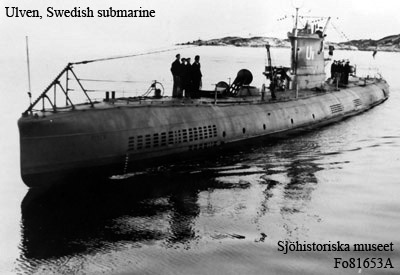

After diplomatic contacts the German Oberkommando der Kriegsmarine on 3 August 1943 insured that they would not drop mines in Swedish training areas, at least not without information to the Swedish navy. [s71]
![]()
A Swedish passenger plane was shot down by a German fighter plane on the west coast of Sweden in 1943 [s05].
A German fishing boat found on 18 September the remains of the Swedish chief pilot on the courier plane Gladan, that had left Dyce in Scotland on 27 August on the flight to Bromma in Sweden. In 1952 a German document from 29 August 1943 was found, with a report about a Swedish courier plane shot down when it flew through the by Germany restricted area around Britain. Luftwaffe had no intentions to inform Sweden, and the German foreign ministry was requested not to issue a communique about it. At the time the political relations between Germany and Sweden were strained, and Germany did not want to make them worse. [s77]
![]()
The Swedish courier plane Gripen was shot down on 23 October 1943. [s64]
Gripen was attacked twice and hit by a German Junkers Ju 88 night fighter, and the pilot tried to land on the water near a Swedish lighthouse. It crashed on rocks and caught fire. Two Swedes survived. Among the passengers from Aberdeen were 6 persons from the Soviet Union, one from Britain and one from the USA. [s77]
![]()
On 19 November 1943 newspapers reported that British bombs fell on the city Lund in southern Sweden, a Swedish naval control officer wrote in his notes. He was on duty on one of the Swedish "lejdtrafiken" merchant ships, anchored in Buenos Aires. [s64]
![]()
A very special history had two Swedish ships that sailed for the Red Cross in the Mediterranean Sea. On 29 December 1943 m/s Camelia hit a mine in Saloniki harbour, and was towed to shallow water where she sank. On 7 February 1944 m/s Wiril was bombed by British planes and set afire. One crew member and the Red Cross delegate were killed, both Swedish, and also a Greek sailor was killed. She was badly damaged, but did not sink.) [s64]
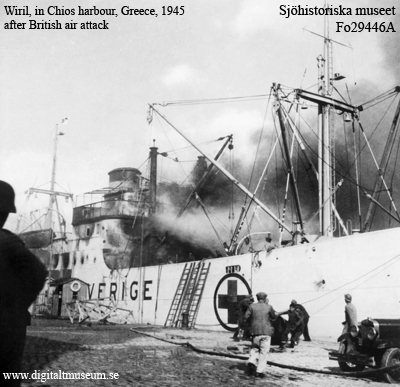
Info about the photo is that it was taken in 1945 - was she bombed twice?
(Apparently a misunderstanding between the Germans and British Red Cross delegates in London about changed time for departure made the British bomber crew believe that it was a camouflaged German ship.) [s65]
In short: After diplomatic and other struggle both ships got minimal provisional repairs at their sites. Camelia was towed to Istambul in Turkey by another Swedish ship in March or April 1944, for more provisional repair. On 1 May 1944 Wiril arrived to Istambul, also for more provisional repair. [s64]
On 1 August 1944 they left Istambul. Wiril - with a temporary bridge - should tow Camelia - who could only be steered from the poop, without a forward view for the steersman - to Sweden. [s64]
In calm waters they could make 9 knots. A 215 metres long Swedish-made steel wire had been bought on the black market. They left the Mediterranean Sea on 16 August, rounded the Azores on 30 August, visited the Faroe Islands for British control of Swedish ships on 11 September, visited Kristiansand in Norway for German control of Swedish ships on 14 September, and sailed into Swedish waters late on 17 September 1944. [s64]
7,000 nautical miles in 46 days and nights, with one damaged ship towing another damaged ship. There were periods of bad weather and some incidents, but they did not hit any mines and were not attacked. [s64]
Amazing.

![]()
Soviet bombs fell over southern Stockholm, and at some locations in the district Sörmland, on 22 February 1944. Two persons were injured. Was the reason a supposed German
ammunition ship that had sailed aground and brought to a harbour near where the bombs fell? (If so, I wonder where it sailed on ground since Stockholm is so far from the open sea.)
Or was the reason a dispute between Sweden and Soviet, since a Soviet citizen working in Sweden had been sentenced to 12 years in prison as a spy?
His petition for mercy had been turned down, but four days after the bombs fell he was released due to psychic reasons. [s06]
![]()
On 13 May 1944 the small tanker BT V had almost finished the filling of German synthetic lubrication oil in Stettin in Germany. Her destination was Stockholm in Sweden. When waves of U.S.A.F. bombers bombed Stettin, the ship was hit and 4 men killed at once. 5 survivors covered in earth from bomb craters waded in oilcovered water to land. [s59]
A German V2 bomb landed in Sweden on 13 June 1944, northwest of Kalmar. Since the vital parts were not so damaged, technicians could write a technical report about the V2 rocket. [s75]
On 18 June 1944 m/t Sigrid Reuter was in Hamburg during a bomb attack on the city. The ship was hit by a bomb and then a couple of fire bombs. 8 men were killed. With the help of some German fireboats the fire was under control after some 14 hours. On 17 July Germans had put in plugs and pumped out the water. The ship had extensive damages, but it was decided to make temporary repairs in a dry dock. On 31 July two large German tugboats began to tow the ship towards Gothenburg in Sweden, where she arrived on 4 August 1944. (There she was repaired, and was back in traffic for several years.). (I think this is fascinating, thinking about the situation in Hamburg at the time. My note.) [s63]
![]()
The passenger ship Hansa, in traffic between Nynäshamn and Visby, was torpedoed on 24 November 1944. 84 people were killed. [s26]
Germany had at the time proclaimed that their operational area in the Baltic Sea stretched as far west as east of Gotland and along a line roughly from Öland and south to the German coast. There were no traffic with foreign ships to or from Swedish ports. Sweden had ended the naval escort for shipping between the mainland and Gotland. [s59]
However Soviet Union submarines preferred to use the Swedish waters between Gotland and the Swedish mainland on their way to and from the southern Baltic Sea. [s59]
As s/s Hansa sailed towards Gotland, she was observed by L 21 who had abandoned a misfortunate period along the Polish coast and was on her way home to the Soviet Union. Among others one of the mines she were to lay had got stuck in the release mechanism. [s59]
Apparently the 563 gross ton Hansa was considered to be a 5,000 or maybe 7,000 gross ton transport ship sailing southwards. (Such size estimation mistakes were not uncommun.). Despite that the captain in the binocular saw that the ship had lights on and that there was something that looked like a flag and text on the side (as neutral Swedish merchant ships had since WWII began), that early morning he fired three torpedoes from 1,600 metres distance. [s59]
![]()
Vesta, a fishing boat, hit a mine and sank. The fishing boat Beltana hit another mine in mid January 1945, and five med died.[s49]
![]()
In the evening of 29 December 1944 the Soviet Union submarine K 56 sank s/s Venersborg. She had made many journeys with iron ore and coal between Sweden and Germany, but now her cargo was paper pulp. This made her sink a little slower, and 16 men managed to get away while 4 men drowned as one lifeboat capsized. Wind and high waves, temperature close to the freezing point, rain mixed with snow, one boat capsized on the way to land, men froze to death. Four men managed to get ashore on an island. The next morning a fisherman discovered and rescued the only survivor. [s59]
![]()
At mid day 3 April 1945 a German Dornier Do 24 flying boat was shot at by the Swedish air defence in Simrishamn. No hits, and the plane continued into Sweden. One minute earlier the alarm was received at a nearby airfield, and one Swedish fighter took off (the second Reggiane Re 2000 Falco 1 failed to start the engine). The fighter caught up with the German plane that had turned to southwest, was hit by fire from the Dornier, and returned towards the airfield. On the way it exploded, and the pilot was killed. [s77]
![]()
The Swedish navy lost 145 men in various accidents, several were killed by foreign mines. [s68]
3,775 mines and 272 explosive buoys were disarmed by the Swedish navy during the war. [s68]
![]()
In May 1945 the Swedish ships who had been cut off from Swedish ports during five years of war, began to return to Sweden. Most of them had been used for the Allies, among others transporting troops, oil and war material. [s63]
94 ships had been lost, foremost due to attacks by German submarines. 1,379 Swedish sailors were killed on Swedish ships, and many hundreds were killed when signed on ships from other nations. [s63]
Around 90 Swedish fishermen had been killed during the war years. [s65]
Totally some 3,000 Swedish sailors were killed due to the war, some hundreds of these were fishermen. [s68]
![]()
A memorial to fallen Swedish sailors, with the inscription "De gåvo sina liv för oss" (They gave their lives for us):

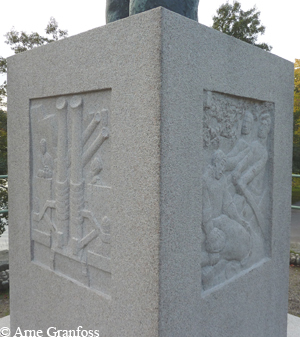
2019-04-07. www.granfoss.se. Text/pictures: Arne Granfoss